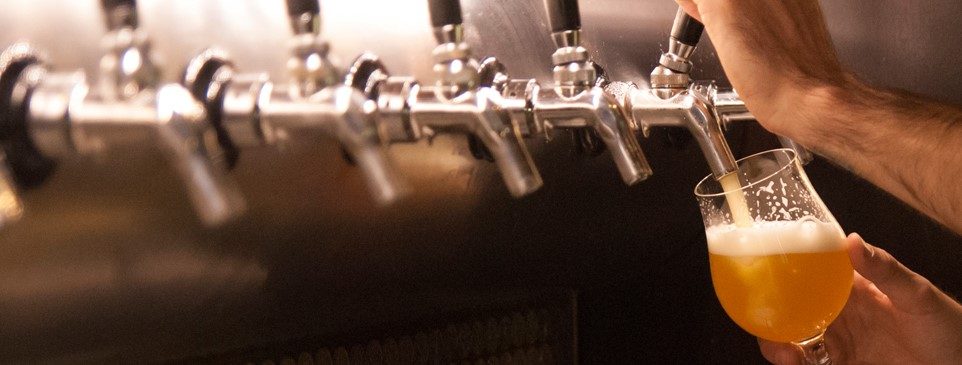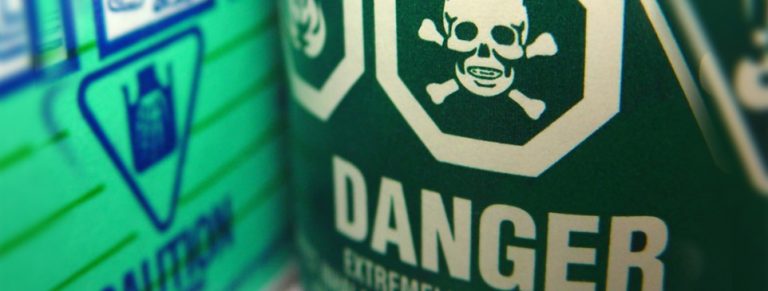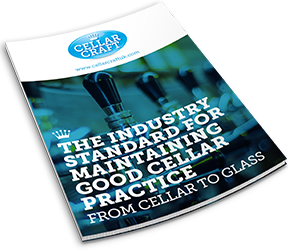What’s in your Beer Line Cleaner

There are 3 different types of beer line cleaner on the market today, each one works in a different way and has their pros and cons. The different types are:
- Caustic / Chlorinated
- Hydrogen Peroxide
- Surfactant based

Caustic / Chlorinated Line Cleaners
These are the traditional style of line cleaner that have been manufactured for over 40 years. These can come in two different styles, clear line cleaners or purple colour indicator (Sometimes called Colour Change Technology).
Basic Caustic / Chlorinated beer line cleaners are a mixture of either Sodium Hydroxide or Potassium Hydroxide (This is the Caustic Part) and Sodium Hypochlorite. More effective and complex beer line cleaners will also contain water softening and scale removing additives. The caustic part is there to aid cleaning but it also stabilises the sodium hypochlorite to increase the shelf life. If a beer line cleaner has been properly balanced then it should have a shelf life of up to 12 months, some cheaper beer line cleaners will only have a 3 month shelf life but because they have not been stabilised properly tests can show they have lost their effectiveness within 1.
The sodium hypochlorite component of these cleaners is the disinfectant and kills bacteria and biological contamination but it does have the downside that it can leave a flavour taint if not properly rinsed from the system. These style of beer line cleaners are also not environmentally friendly and are harmful to health if used improperly.
The idea for a colour changing disinfectant came from ICI who developed Chloros (A caustic / Chlorinated disinfectant which changed colour in the presence of biological soils) in the 1930’s. This used Potassium Permanganate which reacts with biological contamination to change through a range of colours depending (Purple – Blue/Grey – Yellow – Black) on the level of soiling it encounters. There are many variants of purple line cleaner on the market some are more accurate at detecting biological contamination than others, but they will not detect non-biological contamination (even though this style of beerline cleaner can remove it from the system). This means purple beer line cleaners can give a false purple colour for a cleaning as it has removed all the biological contamination and so will be not change colour but there can still be scale and other non-biological contamination in the system if you cut the cleaning shorter than the manufacturers recommendations.
Clear beer line cleaners work in the same way as purple beer line cleaners and in some cases will be exactly the same with just the potassium permanganate removed. Some will have stronger or more effective water softening additives which do not work when the purple colour is present and as such these heavy duty cleaners can not use potassium permanganate but may have a specially developed dye additive to add safety to the clean.
Stabilised Hydrogen Peroxide
This is a very environmentally friendly type of beer line cleaner, it is also non-toxic and fully biodegradable. When Hydrogen Peroxide (H2O2) encounters biological contamination within a beer line system it destroys the walls of bacteria through an oxidation reaction. This method is highly effective and it has a very fast kill rate (1-15 minutes contact time depending on concentration used).

When Hydrogen Peroxide reacts to kill bacteria it is broken down into water and oxygen leaving behind no residue or hazardous chemicals. Most Hydrogen Peroxide based beer lines cleaners are stabilised (this means that they have a longer shelf life than just Hydrogen Peroxide) with elemental silver. Sometimes this silver (which also has antibacterial properties) is left as a residue in the beer line system which can extend the antibacterial effect but this can have issues in live beer systems such as Cask Ales.
All this sounds fantastic but there are down sides to this chemical. Elemental Silver is very expensive and even though only a small amount is added to the Hydrogen Peroxide it has a drastic effect on it’s price with some costing up to £75 per 5L bottle.
Hydrogen Peroxide is very unstable and will begin to react the moment it comes into contact with any biological matter. Dust, dirt, even your finger will cause a reaction turning H2O2 into oxygen and water. Once this reaction has taken place it will no longer work and no longer has its biocidal properties so if anything gets into the bottle or there is anything in the cleaning vessel you are using then the chemical could react before you use it. This means all cleaning equipment must be kept very clean.
Hydrogen Peroxide will not clean any non-biological contamination from your beer line system, so while it will remove bacteria, yeast and protein it will have no effect on beerstone or limescale, this will allow these deposits to build up within the system and effect the flavour of your beer. While Hydrogen Peroxide cleaner manufactures will say that using the product can extend the period between cleans to up to 4 weeks rather than a requirement for weekly cleans, the scales which will build-up in the system act as anchor sites for bacteria to establish biofilm colonies faster than a fully clean beer line, increasing the frequency of cleaning required. This means that as a minimum a Blitz or Deep Clean of the system will be needed at least once per year or you will need to purchase a two stage cleaning chemical (such as the standard system in Australia which uses a peroxide disinfectant clean followed by a caustic detergent clean.) and the cleaning time will become longer than using traditional cleaners.

Surfactant Based Cleaners
This type of line cleaners is less common and there are only a few manufacturers. Like caustic / chlorinated cleaners these will contain either sodium or potassium hydroxide to aid in the cleaning of scales but rather than chlorine as a disinfectant they will use different biocidal chemicals such as Benzalkonium Chloride (BAC), some of the cleaning action will also come from non-ionic surfactants such as Alkyl Polyglucoside (APG).
Surfactants look a little bit like tadpoles (but of course they are chemical not living) and the head end will be hydrophilic (Water Loving) while the tail section will be hydrophobic (water hating) and will prefer to dissolve in soils (such as grease, grime, tannins etc). These work by surrounding the soil and attaching to it using the hydrophobic tail, once the deposit has been surrounded then the soil lifts off the surface of the beer line and is carried away during the water flush (Think of it as tying lots of balloons to a chair and it eventually taking flight and drifting away). The other benefit is that many modern surfactants are now biodegradable and so are more environmentally friendly, but this also has a downside. The surfactants and BAC can actually leach into the surface of the beer line causing a flavour taint which can be difficult to remove also as surfactants lower the surface tension of liquids if there is a contamination of the lines this can lead to beer being served flat as it can make the CO2 gas off from the pint faster. BAC while highly used in surface disinfectants, skin care creams, throat lozenges and medicines is now being replaced due to its skin, eye, gastrointestinal toxicity and because it is classed as an irritant.
The choice of cleaner you use is of course down to your preference but both the advantages and disadvantages should be taken into account.

Download the entire CellarCraft guide
